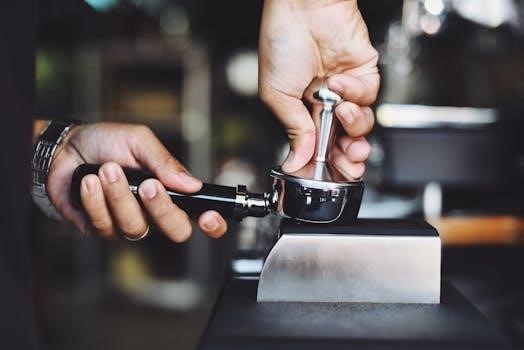This manual provides comprehensive instructions for using the Sage Barista Express. It includes information on setup, operation, and maintenance. The guide covers safety recommendations, component identification, and troubleshooting. It also details how to adjust grind settings and achieve ideal espresso extraction, ensuring a perfect coffee experience.
The Sage Barista Express is a sophisticated home espresso machine designed to bring café-quality coffee into your kitchen. This appliance combines the functionalities of a grinder and an espresso machine, allowing users to control the entire brewing process from bean to cup. It’s engineered to deliver a rich, flavourful espresso by incorporating features such as a built-in conical burr grinder, precise temperature control, and optimal water pressure. The machine emphasizes the four key elements of third-wave specialty coffee⁚ the right dose of freshly ground beans, precise temperature management, optimal water pressure, and proper pre-infusion techniques. The Barista Express provides both manual and pre-programmed settings to cater to varying user preferences, enabling both beginners and experienced home baristas to craft their perfect brew. This machine allows users to adjust grind size, dose amount, and extraction time, making it a versatile tool for coffee enthusiasts. The machine also includes features like a steam wand for frothing milk, expanding beverage creation possibilities. It is designed for countertop use and has a 2-liter water capacity. Understanding the functions and care of the Barista Express is key to maximizing your coffee experience.

Safety Recommendations
Before operating the Sage Barista Express, it is crucial to adhere to several safety recommendations to prevent injury and ensure the longevity of your appliance. Always inspect the power cord, plug, and machine for any signs of damage before each use; if damage is found, immediately stop using the appliance and contact an authorized Sage service center for examination or repair. Installation should be done following residual current safety device recommendations. Avoid immersing the appliance in water or other liquids, and never operate the machine with wet hands. Ensure that the machine is placed on a stable, level surface to prevent tipping. Keep children and pets away from the appliance during operation and when hot. Regularly clean the machine as instructed in the maintenance section to avoid buildup that could affect performance or safety. Only use the machine for its intended purpose, which is to brew coffee, and avoid using attachments or accessories not recommended by Sage. Do not attempt to disassemble or repair the machine yourself; unauthorized repairs may void the warranty. Be careful when handling hot water or steam, and allow the machine to cool down before cleaning. Always switch the machine off and unplug it when not in use or during cleaning.
Components of the Barista Express
The Sage Barista Express comprises several key components designed for efficient and effective espresso brewing. The integrated conical burr grinder allows for fresh grinding of coffee beans directly before extraction, with adjustable grind size settings. The bean hopper, situated on top of the grinder, stores whole coffee beans. The water tank, typically with a two-liter capacity, is located at the back of the machine, providing water for brewing. The portafilter, which holds the ground coffee, locks into the group head for extraction. The steam wand, used for frothing milk, is on the side of the machine. The hot water outlet dispenses hot water for tea or other beverages. The control panel features buttons and dials for selecting shot sizes, and programming settings. The drip tray and storage tray are at the base to collect spills and provide space for storing accessories. The tamper is used for compressing ground coffee in the portafilter. The pressure gauge monitors the brewing pressure. The cleaning tool is used to maintain the machine. These components work together to deliver a cafe-quality espresso experience at home. The user should be familiar with each part to fully utilize the machines potential.

Functions of the Barista Express
The Sage Barista Express offers a range of functions to cater to various coffee preferences. Its integrated conical burr grinder allows users to grind fresh beans directly into the portafilter, ensuring optimal flavor. The grind size can be adjusted to suit different types of coffee beans and desired extraction levels. The machine provides pre-programmed single and double shot volumes, which can be customized to personal preferences. A manual mode allows for complete control over the brewing process, enabling users to experiment with different extraction times and volumes. The steam wand enables the creation of micro-foam for latte art and other milk-based drinks. The hot water function dispenses hot water for tea and other beverages. The machine features a pressure gauge, which provides feedback on the extraction process and helps users achieve the right pressure for optimal results. The Barista Express also includes an automatic cleaning cycle, which simplifies machine maintenance. The grind amount dial allows adjustment of the dose of coffee, and the machine provides a pre-infusion feature which gently soaks the coffee grounds before applying pressure, enhancing the extraction. These functions contribute to the versatility and performance of the machine, providing a complete coffee-making experience.
Setting Up the Barista Express for First Use
Before using your Sage Barista Express for the first time, it is crucial to follow a few setup steps to ensure optimal performance. Begin by unpacking all components and removing any protective materials. Place the machine on a stable, level surface, ensuring there is adequate space around it for ventilation. Fill the water tank with fresh, filtered water to the maximum level indicated. Plug the power cord into a grounded outlet, confirming that the voltage matches the machine’s requirements. Next, perform a cleaning cycle by following the instructions in the manual, which typically involves running hot water through the brew head and steam wand. This process helps to clear any manufacturing residues and prepares the machine for use. Familiarize yourself with the control panel and various settings. Set the grind amount dial to the 3 o’clock position as an initial starting point. It is recommended to start with a medium grind setting and adjust as necessary. Before making espresso, ensure that the portafilter is properly assembled and locked into place. By completing these steps, you are ready to start brewing with your Barista Express.

Adjusting the Conical Burrs
The Sage Barista Express features adjustable conical burrs, which allow you to customize the grind size to suit different types of coffee beans and extraction preferences. Adjusting the burrs is essential for achieving the correct grind consistency, which directly impacts the quality of your espresso. To adjust the grind size, locate the grind size dial, usually located on the side of the machine. This dial typically has a range of settings from coarse to fine. It is recommended to start at the mid-range setting and adjust as needed. If your espresso is extracting too quickly, resulting in a weak and watery shot, you should adjust to a finer grind. Conversely, if the espresso is extracting too slowly, resulting in a bitter taste, you should adjust to a coarser grind. When making adjustments, make small increments, and observe the results. It is best practice to adjust the grind size when the grinder is running and not when it is idle. This ensures the burrs are correctly aligned. Remember that different coffee beans may require different grind settings to achieve optimal extraction, so experimentation and careful adjustments are necessary to fine-tune the process for each type of bean.
Grind Amount Settings
The Sage Barista Express allows you to control the amount of ground coffee dispensed for each dose, ensuring consistency in your espresso preparation. The grind amount setting is typically adjusted using a dial or a button, often located near the grinder. It is vital to set the correct grind amount to achieve the desired brew ratio, which impacts the overall strength and flavor of the espresso. The machine often has pre-programmed settings for single and double shots, but these can be adjusted to suit your preferences. If you find that the pre-programmed settings are not suitable for your needs, you can use the manual mode to customize the grind amount. When using the manual mode, you can control the grind duration by pressing and holding the grind button. The machine will grind until the button is released or until the grind time reaches the maximum, which can then be stopped manually by hitting the button again. Starting with a mid-range setting is a good practice, then adjusting the grind time based on your specific needs is recommended. A small adjustment can lead to a significant difference, so it is important to observe the results and adjust accordingly to achieve the optimal coffee-to-water ratio for your desired taste.
Manual Mode Operation

The manual mode on the Sage Barista Express offers full control over the espresso extraction process, allowing experienced users to fine-tune their brew. Unlike the pre-programmed settings, manual mode lets you determine the duration of both the grinding and the brewing process. This is especially useful for achieving a specific brew ratio or for experimenting with different coffee beans. To initiate the manual grind process, you typically press and hold the grind button; the grinder will operate until the button is released. For manual espresso extraction, you can activate the brew function and stop it manually when the desired amount of espresso is achieved. In manual mode, you are responsible for monitoring the extraction time and volume, which allows you to adjust your process based on real-time feedback. This method requires practice and attention, as each variable can affect the final taste. Using the manual mode, you can achieve a more custom extraction. For example, you might choose to stop it earlier for a ristretto or later for a lungo. By closely controlling the process and making adjustments as necessary, you can significantly influence the outcome of your brew. The user manual provides further details on how to control these variables.
Espresso Extraction and Brew Ratio
Espresso extraction is a crucial element in achieving a high-quality cup of coffee, and the brew ratio plays a significant role in this process. The brew ratio refers to the proportion of ground coffee to the liquid espresso extracted. A standard ratio often recommended is 1⁚2, meaning for every gram of ground coffee, you extract two grams of liquid espresso. For example, if you use 18 grams of ground coffee, the target would be 36 grams of extracted espresso. The ideal extraction time is generally between 25 to 30 seconds, which ensures that the optimal flavor compounds are extracted from the coffee grounds without over or under extracting. A balanced extraction results in a rich, full-bodied espresso with a sweet, pleasant taste and a creamy texture. Factors such as the fineness of the grind, the tamping pressure, and the water temperature can also impact the extraction process, influencing the taste and overall quality. Understanding the brew ratio and its effect on the final product allows you to adjust your settings and techniques to consistently produce a satisfying espresso. Pre-programmed settings may not always produce the desired result, making it useful to use the manual mode to fine-tune the brew ratio based on your preference and the type of beans used. Learning to control the variables allows you to achieve the perfect extraction. The user manual provides further details and guidelines.
Care and Cleaning of the Barista Express
Proper care and cleaning are essential to maintain the performance and longevity of your Barista Express. Regular cleaning ensures that your machine consistently delivers high-quality espresso and prevents the buildup of coffee oils and residues, which can affect the taste. After each use, it is recommended to empty the drip tray and the spent coffee grounds from the portafilter. The portafilter should be rinsed under warm water to remove any remaining coffee particles. The steam wand should be purged immediately after steaming milk and wiped clean with a damp cloth. Regularly clean the water tank and replace the water when needed. It is important to descale the machine periodically to remove mineral buildup, which can impact the machine’s performance. The frequency of descaling depends on the water hardness and how often you use the machine. The burr grinder should be cleaned regularly to prevent blockages from coffee grounds. The user manual usually provides detailed instructions on how to clean each part of the machine. Use a soft cloth for external cleaning and avoid abrasive cleaners that can damage the finish. Regularly inspect the power cord and other parts for any damage. By following these cleaning and maintenance practices, you can ensure that your Barista Express remains in optimal working condition and continues to provide you with excellent coffee for years to come.
Troubleshooting Common Issues
Encountering issues with your Sage Barista Express is not uncommon, and understanding how to troubleshoot them can save you time and frustration. One frequent problem is inconsistent espresso extraction, which may be due to an incorrect grind size. Adjusting the grinder to a finer or coarser setting can often resolve this. If the espresso is extracting too slowly or not at all, check for blockages in the portafilter or grinder. Ensure the water tank is filled and the machine is properly powered on; Another common issue is milk not frothing correctly. This could be due to a blocked steam wand or the milk being too cold. Make sure the steam wand is clean and use fresh, cold milk. If the machine is not heating up or the lights are not illuminating, inspect the power cord and connections. If your machine is making unusual noises, it may require descaling or cleaning of internal parts. The user manual provides detailed troubleshooting guides for specific issues. If basic troubleshooting does not resolve the problem, it is recommended to contact an authorized Sage service center for professional assistance. Regularly inspecting and cleaning your machine can prevent many common issues from occurring. Always refer to the manual for detailed instructions and do not hesitate to seek professional help when needed. By taking these steps, you can effectively address most common issues with the Barista Express.
Pre-Infusion Techniques
Pre-infusion is a vital step in the espresso extraction process, and the Sage Barista Express allows for both automatic and manual control of this phase. Pre-infusion involves wetting the coffee grounds with low-pressure water before the full extraction pressure is applied. This gentle saturation helps the grounds swell, ensuring even extraction and a more balanced flavor profile. The automatic pre-infusion setting on the Barista Express typically delivers a short, low-pressure water burst before the main extraction cycle. For those seeking more control, the manual mode allows users to manipulate the pre-infusion duration. To manually pre-infuse, engage the brew button and hold it down for the desired duration before releasing to begin the full extraction. Experimenting with different pre-infusion times can significantly impact the final taste of your espresso. Longer pre-infusion times may result in a smoother, less bitter shot, while shorter times can enhance the acidity and brightness of the coffee. Observation is key, so pay attention to how the extraction looks and adjust your pre-infusion technique to achieve the desired results. Practice and experimentation are crucial to mastering pre-infusion, enabling you to customize your coffee to your taste preferences. Remember to keep notes on your process to ensure repeatable results. Mastering this technique is a significant step towards creating cafe-quality espresso at home.
Warranty Information
The Sage Barista Express comes with a limited warranty that covers defects in materials and workmanship under normal domestic use. The specific duration of the warranty may vary depending on your region, so it’s essential to refer to the documentation included with your machine for precise details. Typically, the warranty period starts from the date of purchase and requires proof of purchase to be valid. This warranty protects against manufacturing flaws that may appear during the specified timeframe. It’s important to note that this warranty does not cover damage caused by misuse, abuse, accidents, or unauthorized repairs. Regular maintenance, such as cleaning and descaling, as outlined in this manual, is essential for maintaining the warranty’s validity. If you encounter an issue covered under warranty, it is imperative to contact an authorized Sage service center for examination, replacement, or repair. Attempting repairs yourself or using non-authorized service providers will void the warranty. To ensure a smooth warranty process, keep your original purchase receipt and register your product with Sage as soon as possible. For detailed warranty terms, conditions, and procedures, always refer to the official warranty documentation supplied with your Barista Express. Understanding the warranty is crucial for safeguarding your investment and ensuring access to support when needed. Regular reviews of the warranty are advised, especially if there are any concerns about the functionality of your machine.

Leave a Reply
You must be logged in to post a comment.